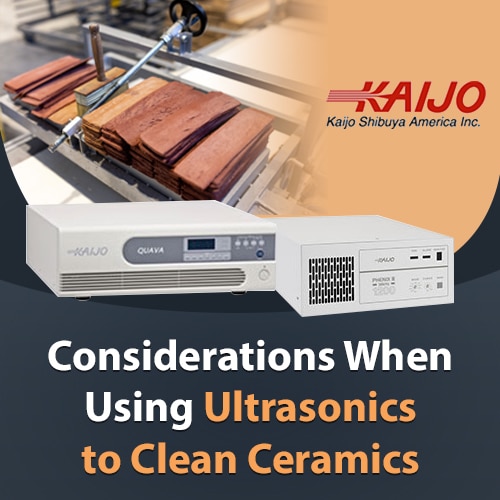Considerations When Using Ultrasonics to Clean Ceramics
March 10, 2022
 While the term “ceramics” applies to a wide variety of materials, they all have some common characteristics that allow ceramic parts to be cleaned effectively with ultrasonics. Items made from ceramics range from common brown flower pots through precision medical equipment to high-temperature parts. Many industrial ceramic parts have specific contaminants, with custom ultrasonic cleaners designed to meet their special cleaning requirements.
While the term “ceramics” applies to a wide variety of materials, they all have some common characteristics that allow ceramic parts to be cleaned effectively with ultrasonics. Items made from ceramics range from common brown flower pots through precision medical equipment to high-temperature parts. Many industrial ceramic parts have specific contaminants, with custom ultrasonic cleaners designed to meet their special cleaning requirements.
Depending on the cleaning application, ultrasonic parts cleaners can quickly remove light contamination, deep clean with the addition of heat and mild solvents to remove heavy dirt or sterilize medical instruments with disinfectants. An experienced manufacturer can deliver exactly the right ultrasonic cleaning system to clean specific ceramic parts.
Ultrasonic Cleaners Can Clean All Types of Ceramic Parts Quickly and Completely
The term “ceramics” refers to inorganic non-metallic materials that are partially fused by heating the materials to create a hard, heat-resistant, and corrosion-resistant product. Typical raw inputs that are heated to produce industrial parts include common materials such as clay or sand and minerals such as silicon carbide, tungsten carbide, alumina, or ferrite.
Ceramic parts to be cleaned can include the following:
- Heat-resistant tiles for furnaces
- Cooktops for consumer and commercial stoves
- Fired bricks for furnaces and chimneys
- Cutting tools
- Brake pads
- Tool bits
- Heat shields
- Tubes and nozzles
- Medical implants
- Permanent magnets
The properties that all ceramic parts share in common are that they all have hard surfaces, resist high temperatures, and are impervious to solvents. As a result, low ultrasonic frequencies delivering powerful cleaning action and heated baths with solvents can deliver unparalleled cleaning performance.
The ways in which they differ include:
- Some products need to be cleaned right after the completion of the manufacturing process. Ultrasonic cleaners can quickly remove shop dirt and lubricants used in producing the parts.
- Other parts, such as medical implants, have to be cleaned prior to use. Ultrasonic cleaners can be used with a sterilizing solution to make sure medical parts and instruments are safe.
- Parts used in industrial production, such as tools or nozzles, become contaminated with process materials and have to be cleaned before being used again.
- Sometimes contaminants can be difficult to remove, such as hardened oil and grease or carbon deposits. In these cases, ultrasonic parts cleaners can be used with heated baths that operate at temperatures just below boiling to soften heavy deposits.
- For some contaminating materials, solvents that soften and dissolve a specific material help speed up cleaning.
Other Options to Improve Cleaning of Ceramics
Some ceramic parts may have very small holes and crevices and cleaning surface contaminants in these situations can be very difficult. In these cases, the effectiveness of Kaijo’s ultrasonic cleaning systems can be further enhanced by using the water treatment technology of the Water Resonance System (WRS). When used with Kaijo’s ultrasonic systems the WRS conditions the water to improve bubble formation and overall cleaning performance. Ultrasonic cleaning systems using the WRS will effectively clean ceramic parts with small holes and crevices more uniformly.
Cleaning Ceramics with Ultrasonics Delivers Substantial Benefits
Traditional cleaning methods include soaking in chemicals, manual scrubbing and scraping, power washing, and steam sterilization. These methods are time-consuming and may damage the parts to be cleaned. Employees can suffer injuries from the cleaning tools they use and strong chemicals may be hazardous. Well-designed ultrasonic cleaners eliminate all these issues.
Ultrasonic cleaners work by generating microscopic cavitation bubbles in the cleaning solution. When a bubble bursts, a powerful jet of liquid dislodges contaminants from the surface of the parts to be cleaned. The process is completely safe and does not need monitoring. Employees can place the parts into the cleaning solution, set a timer, and come back later to remove the completely clean parts.
Benefits include:
- No harsh chemicals to store, use and dispose of
- Complete cleaning, even around complex shapes
- Fast cleaning action while employees carry out other work
- Increased workplace safety
- Reduced operating costs
Taking advantage of these benefits depends on choosing the right ultrasonic cleaner. A competent manufacturer can help with the choice of system parameters such as frequency, power, tank size, transducer configuration, and suitable solvents for your specific cleaning challenge.
Kaijo’s Expertise in Providing Effective Cleaning Solutions
As a leading ultrasonic cleaner manufacturer with years of experience and deep expertise, Kaijo’s experts are skilled at helping customers use the right ultrasonic cleaning system. Kaijo works closely with clients who have special requirements for cleaning ceramic parts. If needed Kaijo can design and build custom systems that meet unique needs to deliver the desired cleaning performance.





